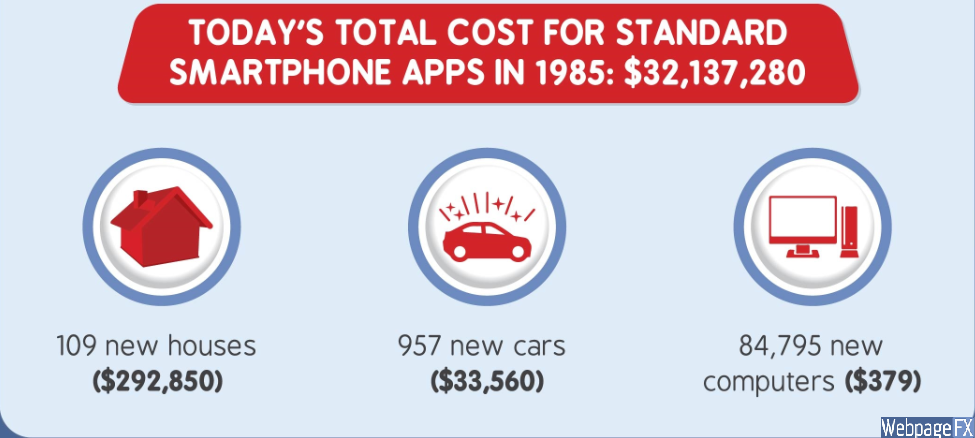-
 13 min. read
13 min. read
-
 WebFX Team
WebFX Team Digital Marketing Agency
Digital Marketing Agency
- The WebFX team is made up of more than 450 subject matter experts in digital marketing, SEO, web design and web development, social media, and more. Together, they’ve helped WebFX’s clients earn more than $3 billion in revenue from the web — and that’s just in the past five years. @webfx
In the 1980s, the world was changing rapidly. Personal computers, video phone calls, mobile stereos, fax machines, and tons of other technological innovations took the world by storm. Businesses everywhere scrambled to keep up with the latest tech and gadgets so they could stay at (or climb to) the top of their industries.
But today, all of that awesome tech stuff is right on your phone — and then some — at a fraction of the cost. So how much did it all cost originally? What did someone pay when they wanted the convenience, power, and utility of a smartphone in 1985?
That’s what we wanted to find out. And fair warning: This may get a little Andy Rooney.
The cost of everything on your smartphone in 1985

Which smartphone features we researched
When we were researching this infographic, we decided to only look up the functionality that most smartphones have in common. So that includes a telephone, text messaging / SMS, calendars, notes, and — most importantly — processing power (among others).
Those features are all consistently used across iPhones, Androids, Windows, and Blackberries, so we determined they were the best features to highlight in this infographic.
Function #1: Mobile phone

Your average smartphone can go for as little as $20, not including carrier fees.
Function #2: Text / image messaging

And paper. And ink. And patience, because waiting for a fax to come through also felt a lot like waiting for a bus.
Compare that to today’s instant-gratification of a full-color photo of your friend’s lunch right in your pocket, and it’s like comparing the first wheel to the space shuttle.
Function #3: GPS

Today, almost everyone has a GPS built directly into their phone, and it’s a whole lot more reliable than the Magellan NAV 1000. Although to be fair, Magellan still makes GPS units today. And they’re way better than the NAV 1000.
Function #4: Voice recorder

Today, your voice recorder is a couple taps away. Depending on the apps you use, you can upload a recording straight to the cloud too, meaning you have instantaneous copies. You don’t even have to store it locally on your phone.
It’s like if you could store a cassette’s audio data on radio waves.
Function #5: Digital watch

You needed fingers like pipe cleaners to actually hit the buttons correctly, but other than that, this watch was great, and you could get it for $45 by today’s standards. Still, that’s $45 down the drain when you consider that your phone’s screen defaults to showing you the time. So unless you want to look professional (or if you really like watches), you can probably save your wrist for a FitBit or an Apple Watch these days.
Function #6: Portable music player

They created the D-50 Discman around 1985, and for the obscene price of $400 (by today’s standards), you could listen to any CD you wanted. It skipped when you walked, you couldn’t hold it vertically for very long, and it didn’t conveniently fit anywhere when you’re on the go, but hey — baby steps, right? Compare that to your phone’s digital music player that never skips and never cares whether you’re jogging, sitting, or rocketing out of the planet’s atmosphere, and it’s like sitting a Yugo next to a Rolls Royce.
Function #7: Encyclopedias

That knowledge didn’t have to be about anything specific — if you wanted to know something, their books could tell you. Now, the Internet does all of that, and Internet access costs a whole lot less than what a set of Britannica’s reference books. It’s also updated more often, written conversationally (most of the time), and accessible.
Encyclopedia Britannica is still a reliable source of information, but on the Internet, you can probably find the same stuff somewhere else.
Function #8: Radio

Now, Internet radio is widely available. And beyond that, you can use podcasts, almost all of which are free and readily available on most smartphones, instead of radio. You don’t look quite as a boss when you’re wearing a set of Beats on your head, but it’s better than getting a sore shoulder spending a day with a giant stereo next to your head.
Function #9: Video game console

But Nintendo doesn’t make anything that’s as convenient and easy to use as app store games. You can get these games for way less money than a 1985 Nintendo game, and you can get them a lot faster, too. Plus, the console, game, and screen are all in one device — you just tap to get started.
The Nintendo Entertainment System was revolutionary in its time, but at $440, it’s a bit of a pinch compared to Angry Birds at $1.99.
Function #10: Portable television

And the same was true for portable TVs. The reception wasn’t the greatest, and the volume couldn’t go up too loud, but these portable TVs were great for long road trips and lunch breaks when you could get reception. In 2016, all you need is a phone with a 3G connection and you can look up anything on YouTube, Hulu, or Netflix. The picture is a whole lot better, and it only costs you when you go over your data limit.
Function #11: Film camera

They were the perfect vacation companion, and some of them could fit right in the pockets of your acid wash denim jeans. The pictures weren’t great — you couldn’t do much with a lens that small — and you could ruin the film by exposing it to light, but they got the job done. But the digital camera on your smartphone is much more powerful, precise, and convenient, especially since you can’t accidentally destroy your photos by taking your phone from your pocket.
Plus, you could spend a day playing around with the pre-loaded filters your phone has. Because everyone’s seen your lunch — but have they seen it in sepia?
Function #12: Video camera

Even so, it’s a lot more work than filming something and uploading it to YouTube with three taps of your finger.
Function #13: Video player

But — also by today’s standards — VCRs had a grainy picture, their tapes wore out, and they took surprisingly long to rewind. And to this day, nobody knows how to program one.
Function #14: Video conferencing

And it’s even easier to directly call someone with Skype, Facetime, and other services that are free. But in 1985, that was some primo tech. If businesses wanted to talk to other branches face-to-face, they needed to pony up some serious cash for a lackluster picture, spotty service, and lots of prep time.
Considering it cost $110,520 (plus usage fees) in 1985, calling someone for free on Skype has never felt so good.
Function #15: Processing power

Most smartphones have the power of about 1.9 gigaflops. Even with how ridiculous that unit of measurement sounds, it says a lot when you look at how far it’s come. Because in 1985, you needed $32 million to buy the latest supercomputer just to match what you carry in your pocket.
And keep in mind this didn’t have the functionality of your smartphone either — this was 1985, and that meant creating a spreadsheet was a headache. The Cray-2 supercomputer was the fastest computer in the world for a time. Today, all of that power and speed is smaller than your hand (and a lot more convenient), and it can’t hold a torch to something like IBM’s Watson.
What could you buy for all that money?

Share this infographic
Let your friends and coworkers know how much power is packed into that little device in your pocket. Share this infographic using the social buttons in the sidebar!
And if you’d like to add your own input, feel free to use our embed code to host a copy of this infographic on your site!
-
 The WebFX team is made up of more than 450 subject matter experts in digital marketing, SEO, web design and web development, social media, and more. Together, they’ve helped WebFX’s clients earn more than $3 billion in revenue from the web — and that’s just in the past five years.@webfx
The WebFX team is made up of more than 450 subject matter experts in digital marketing, SEO, web design and web development, social media, and more. Together, they’ve helped WebFX’s clients earn more than $3 billion in revenue from the web — and that’s just in the past five years.@webfx -

WebFX is a full-service marketing agency with 1,100+ client reviews and a 4.9-star rating on Clutch! Find out how our expert team and revenue-accelerating tech can drive results for you! Learn more
The Internet in Real Time
Ever wonder how much is going on at once on the Internet? It can be tough to wrap your mind around it, but we’ve put together a nice visual that’ll help! The numbers show no sign of slowing down either.
Find out More
Table of Contents
- The Cost of Everything on Your Smartphone in 1985
- Which Smartphone Features We Researched
- Function #1: Mobile Phone
- Function #2: Text / Image Messaging
- Function #3: GPS
- Function #4: Voice Recorder
- Function #5: Digital Watch
- Function #6: Portable Music Player
- Function #7: Encyclopedias
- Function #8: Radio
- Function #9: Video Game Console
- Function #10: Portable Television
- Function #11: Film Camera
- Function #12: Video Camera
- Function #13: Video Player
- Function #14: Video Conferencing
- Function #15: Processing Power
- What Could You Buy for All That Money?
- Share This Infographic

Ready to Drive Results for Your Business?
See how WebFX uses SEO, PPC, Social Media, and Web Design to Drive Revenue for Businesses.
Get InspiredThe Internet in Real Time
Ever wonder how much is going on at once on the Internet? It can be tough to wrap your mind around it, but we’ve put together a nice visual that’ll help! The numbers show no sign of slowing down either.
Find out More





